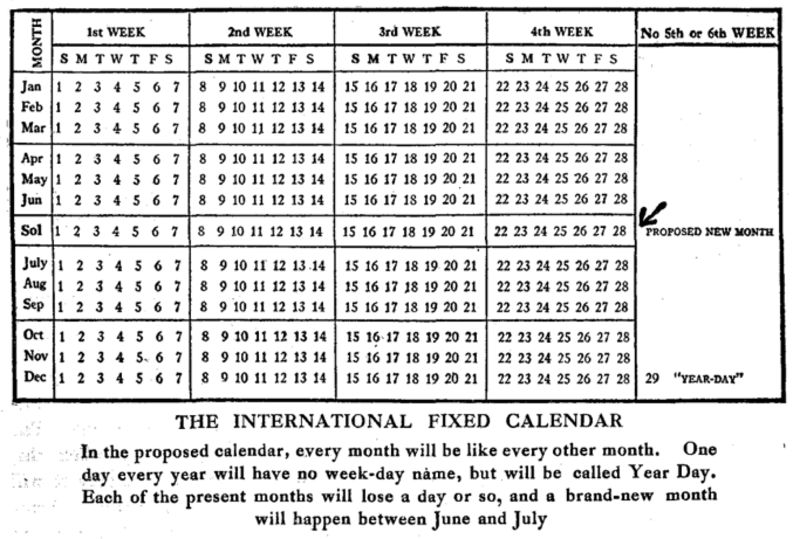Fixed Calendar & Metric System
- The Fixed Calendar is perfect: The word “month” aptly comes from “moon” because months are supposed to be based on the lunar cycle, which is about 29.5 days long. However, to stay in tune with a solar year of 365 days for the earth revolving around the sun, we would have 13 months of only 28 days each, totaling 364 days. Plus we would have an extra day at the end of the year called “Year Day” to make it a full 365 days. Year Day would come after New Years Eve and before New Years Day. This completes a solar year and remains accurate to the seasons. Then every 4 years, we add “Leap Day” after Year Day. This tracks our regular 4 seasons of 13 weeks each while being closer to the lunar cycle than our current Gregorian calendar.
- The Fixed calendar is easy to use: You wouldn’t have to remember which months have 28-31 days because each month would have 28 days! This makes it easy to divide up a month into 4 even weeks. Months would have a fixed 28 days and each month’s numbered weekdays would match all over months. This is unlike the current Gregorian calendar, where months are staggered 28 – 31 days and some weeks carry over into the following month. Also, it would be easier to keep track of our 4 seasons of 13 weeks each as well as the equinoxes and solstices. The first day of the year would be the spring equinox (first day of spring) to commemorate new life and a new beginning. This is our current March 20.
- Rename the months so they make sense: December is currently our 12th month but means “10th” with the prefix “dec.” September means “seventh” with prefix “sept” but is our ninth month. October means 9 but is our 10th month, and so on. The names are not consistent with the month number. We would revamp the names so they make sense: Una, Dosa, Tresa, Quatra, Penta, Sessa, Septa, Octa, Nova and Deca. Una 1 is the first day of the year and is also the spring equinox and first day of spring. Quatra 8 (4/8) is the summer solstice and first day of summer. Septa 15 (7/15) is the fall equinox (first day of fall) and mid-year point. Deca 22 (10/22) is the winter solstice (first day of winter). We would make our new holiday and birth dates consistent with the old calendar.
- We can rename the days of the week: If we keep the current names of the week, then the 13th of each month would always fall on a Friday, so each month would have a Friday the 13th, and since this calendar is 13 months long, we would have thirteen Friday the 13th’s every year! Thirteen Friday the 13th’s makes every year a lucky year! However, we could instead rename the days of the week to align with the order of celestial bodies from the sun: Hermes (Mercury), Venus, Terra (Earth), Lune (Moon), Ares (Mars), Thor (Jupiter), and Cronus (Saturn). I prefer this because I think it’s more meaningful than our current week names and it would help people remember the order of the planets from the sun.
- The fixed calendar evokes Justice: The Jewish people traditionally follow a similar lunisolar calendar which begins the year in Spring to mark their freedom from Egypt (Exodus 12:2). After their liberation from slavery in Egypt, the Jews were later conquered by the Romans, who, after a Jewish revolt, destroyed Jerusalem and the Second Temple in 70 CE (AD). At this time, Jews were either enslaved, killed or exiled from their homeland. The destruction of the Second Temple took place after its first destruction by the Babylonians in 587 BCE when it was called the First Temple. The Wailing Wall in Jerusalem is the remains of the Second Temple after it was destroyed by the Romans. Adopting the fixed calendar would help honor Jewish resilience after centuries of abuse.
- Other perks of the Fixed calendar: We would have an extra one day per year called Year Day between New Years Eve and New Years Day. This day would mark the transition between the years and would serve as a holiday. The Fixed calendar also accommodates businesses. “How do we break up a 13 month calendar into quarters for quarterly results? It doesn’t divide by 4 easily.” Solution: Yes it does! Divide the Fixed Calendar into quarters of 13 weeks each. Corporate quarterlies would be the same 13 weeks each year – the dates would just match the dates of the seasons! This calendar solves all your calendar problems!
- The Fixed calendar lowers monthly bills: Complaint: “An extra month means an extra month’s rent.” Solution: Rent and bills would be pro-rated to reflect a 13 month calendar instead of a 13 month calendar! So it would actually lower your rent. This actually means lower monthly payments and more opportunities to cancel monthly subscriptions! Also, if companies do try to exploit this new calendar to charge a higher annual rate for their services, we can make new laws and regulations to prevent such abuse!
Let’s switch to the Fixed Calendar, and the Metric System!
I am a freelance artist. If you found this page helpful, please consider supporting me through my donate page. Thank you.
